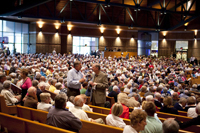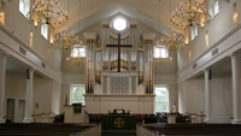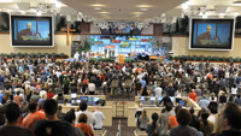

Keeping the Economic Faith: Houses of Worship Roundtable
Oct 9, 2009 12:00 PM,
By Dan Daley
Six industry experts weigh in on the current and future HOW market.
With the down economy, AV integrators are seeing a wide range of impact in the HOW market. For example, halfway through the audio system renovation at Christ Memorial Church in Holland, Mich., the design had to be changed to include less expensive L-Acoustics 115XT HiQ loudspeakers placed individually rather than in an array, which have would required more boxes.
In a recent interview on cnet.com, Brady Boyd, pastor of the 10,000-plus member nondenominational New Life Church in Colorado Springs, Colo., cast the relationship between church and technology in simple monetary terms: “because technology is so expensive, churches sometimes stay put. They stop advancing because cost-wise, it’s just so difficult to keep up with the latest technology.”
Amid a two-year-long recession, it’s difficult to analyze anything except through the prism of economics. So we asked several leading systems integrators and consultants who specialize in the house of worship market for their thoughts on digital and dollars under the nave. They are John Westra, president Audio Design Specialists in Madison, Wis.; Tim Carlson, executive vice president at AMT Systems in Santa Clarita, Calif.; Ian Budd, president of ICB Audio & Video Equipment in Cincinnati; Dan Clayton, principal with Clayton Acoustics Group in Carmel, N.Y.; Val Dempsey, CEO of Communications & Entertainment in Atlanta; and Bill Thrasher, president of Thrasher Design Group in Kennesaw, Ga.
SVC: In an era of lowered expectations, what are your HOW clients doing in terms of upgrades versus new AV systems? Are they opting to keep existing systems going no matter what, or do they see this as a buying opportunity?
Carlson: More money would be spent if we weren’t in a recession, certainly, but I’m not seeing any pullback on production values. The expectations for higher quality are still there, but in many cases, they’re deferred. A church might realize it needs a new sound or video system, but it just laid some employees off. So some projects will be on hold as a result.
Budd: We have been seeing a tendency towards maintaining the existing systems or adding features to the existing systems—all with a goal of keeping within a lower budget driven by lower giving.
Clayton: Lately, many of our clients have begun by lowering their expectation of how much they would like to pay us. [Laughs]
Dempsey: The opportunity is that every buyer in any industry is spending less than usual and expects better deals. This economy has put some projects on hold or scaled back due to funding.
Thrasher: It’s in-between. A lot of what’s going on is replacement of components or system expansion rather than installing complete new systems, but it’s a buying opportunity for the replacement equipment.
Keeping the Economic Faith: Houses of Worship Roundtable
Oct 9, 2009 12:00 PM,
By Dan Daley
Six industry experts weigh in on the current and future HOW market.
In a down economy, is midsized the new mega? What does that mean for HOW AV technology in general?
Thrasher: Midsized is the new mega—for now. Churches, like everything else, tend to go in cycles. There’s a period where 10,000-seat rooms are in fashion, and then it’s 3,000-seat rooms. We’re in the latter cycle now.
Westra: We have seen a trend over the last three years away from mega auditoria, if not away from mega churches. Instead of one large auditorium, a church with high membership will build a church will multiple smaller auditoria, which can operate separately as well as linked. The net result may actually be a higher expenditure per seat. My personal view is that if the members of a church conduct their financing according to biblical principles, the church will be immunized from a bad economy.
Carlson: Everyone is amazed at what they see at Willow Creek or Saddleback, but most churches don’t have those kinds of finances. What we’ve seen is that as original members of congregations, who joined when the worship style was more conventional, bump into younger congregants who have different expectations of sound and video. The solution is to use multiple services that meet each group’s expectations. The AV technology has to be able to scale to do that. That’s a challenge.
Clayton: While the term “mega” usually doesn’t apply to our range of projects, we did go through a period where even traditional worship space clients were requesting and expecting an ever greater package of functions and features. It seemed the only way to satisfy their needs was by designing bigger, fancier, and more expensive systems. Some of the projects got out of hand, quite frankly. They taxed the capacity of a small consultant’s office, were hard for the contractors to implement, and very difficult for the users to understand and even use properly. During the past year or two, we have scaled back our designs to be more in line with the level of work we did 10 years ago—at least in functional terms of the hardware.
Dempsey: It depends on whether you are talking about economics or physical size. Mega is big and requires bigger solutions. Some solutions are being installed in stages due to budgets. AV continues to be very important to any church, and some are able to take advantage of this economy while others are struggling where they would not in a better economy.
What digital AV technologies/products are you recommending as most cost-effective and why?
Westra: We recommend the best possible digital processors for crossover, equalization, delay, and limiting functions, and then hope that the clients don’t tinker with them. We would only recommend digital consoles in very limited applications where truly qualified operators were present due to the learning curve.
Carlson: That’s always going to be limited by budgets, but in general, we’ve been encouraging the use of digital consoles. They’re more costly than analog consoles, but they improve performance to the point that they’re more cost-effective.
Budd: Digital consoles and digital processors are still the mainstays of the digital technologies we are recommending to our customers.
Clayton: Networked digital audio implemented in DSP-based mixing/routing/signal processing systems lets us do a lot with a little, especially in terms of minimal equipment rack space and streamlined system infrastructure. We also like using steered line-array loudspeakers in reverberant buildings, both for the excellent electro-acoustic results and relative simplicity of working with many fewer loudspeakers than are needed with most other design approaches.
Dempsey: Digital snakes and consoles require a lot less infrastructure and offer more flexibility. DSP technology continues to become more prevalent in systems of all sizes.
Thrasher: For audio, the Yamaha M7CL is the best buy on the market. It’s actually easier to use than many analog consoles. And we’re also recommending fiber for all control and equipment spaces, even if we don’t terminate it and leave it dark.
Keeping the Economic Faith: Houses of Worship Roundtable
Oct 9, 2009 12:00 PM,
By Dan Daley
Six industry experts weigh in on the current and future HOW market.
Are HOWs moving toward HD video at any cost, or is cost keeping them at the SD level?
Westra: The high cost of HD was a hindrance even before the drop in the economy, and I expect that status to continue.
Carlson: Cost is an issue, and it’s a slow process, though we are seeing some churches now moving to HD video. But the process will require more education. As soon as you say “HD,” people expect a videoconferencing camera to look like ESPN HD. They have to understand that HD, like a lot of technologies, is always a good-better-best proposition.
Budd: Our market is fairly conservative, so we find this happening with a few of our more innovative clients, but it is generally quite limited at this time.
Dempsey: Our video upgrades and new installations are all proposed HD. For various reasons, including budget, some stay at or go with SD.
Thrasher: They’re moving to HD, but not at any cost. Churches remain very cost-conscious. That said, in five years there won’t be any SD video equipment out there to buy anymore, so they have to move forward. Fortunately, costs are coming down.
Are midlevel HOWs leveraging lower-cost technologies to try to reach parity with larger HOWs? Any examples of how that’s been successful?
Westra: Our experience is that the technical systems investment is a function of the denomination and the culture, plus what other similar churches are in the same area. Some denominations want the cheapest solutions irrespective of size, and place no priority upon media technology. Others are foolishly wasteful, buying expensive products that they don’t need and have no chance of using properly. On some recent projects, at our advice, churches have opted to invest in proper acoustics and proper basic systems, which would be costly to upgrade later, but used smaller mixers and scaled back monitor systems initially—as these areas can be upgraded later conveniently and cost effectively.
Carlson: Churches try to mimic what they see elsewhere, yes. [Christian music artist] Lincoln Brewster came to a church with a full production crew, and they transformed the stage with lighting and custom banners. After that, the church bought its own plotter to cut custom vinyl for banners and added LED lighting. There are more and more solutions that are affordable enough to let that happen.
Budd: Largely, we find this being done at the more basic level. For example, purchasing lower-cost high-brightness video projectors.
Dempsey: They are trying to, but usually with limited success. There is no substitute for using the right equipment for the application. Trying to save money on a dimmer projector or smaller display most often is a waste of funds. We usually recommend that the client raises funds for the right solution rather than compromising performance and being disappointed.
Now that the white spaces issue has been more or less settled for the time being, how are your HOW clients reacting? Are they changing out their old wireless systems yet? Has it even been an issue for them? Is this an opportunity for integrators? (Editor’s Note: Listen to “The Latest on Wireless Mic Systems” webcast to learn more about the white space issue.)
Westra: We notified many existing clients of the change, and a few upgraded, some were already compliant by luck, and some did not care. Those that did upgrade, purchased relatively inexpensive replacements. [The newest] systems automatically use wireless products that are compliant.
Carlson: We’ve done a number of installs that have upgraded from 700MHz wireless. Manufacturers’ rebate programs have helped that. But one of the problems is the FCC’s own database is not really complete, so neither are those provided by manufacturers. There are contingencies for certain entities to still stay on the old spectrum and sometimes churches bump into that. The dust hasn’t settled yet.
Budd: Some have been changing out their systems, especially if they are already heading toward the end of their useful life. However, there is very much a wait-and-see attitude out there. If it’s still working, why fix it until it breaks? However, we have had a good response to the wireless microphone manufacturer rebate programs that have been offered for upgrades to compliant frequencies. Those incentives have been sufficient to tip the balance in favor of upgrading for several churches that might not have otherwise done so.
Dempsey: Immediately it has not had much impact, but we expect it to. Because it’s not been much of a problem yet, clients are slow to react to upgrading. It will definitely become an issue, though, and will present opportunities for integrators.
Thrasher: We’re seeing a lot of incremental replacement. Churches don’t have the money to replace entire wireless systems, so they’re doing a few here and few there. But more importantly, I think they’re gun-shy about whether the white spaces issue has been fully resolved going forward. They’re realizing that wireless isn’t a 10-year investment anymore. So they’re tending to buy cheaper in case they have to buy again sooner than they thought.
Keeping the Economic Faith: Houses of Worship Roundtable
Oct 9, 2009 12:00 PM,
By Dan Daley
Six industry experts weigh in on the current and future HOW market.
As more digital technology comes into HOW facilities, the learning curve is ramping up, especially for HD video and digital audio consoles and routers. Is the tech talent base keeping sufficiently? Is it still mostly volunteers or do you see more professionals being hired to run these systems?
Westra: The talent base is not keeping up. Most operators learn just enough of the language to be dangerous and show no interest in developing further. They see the hardware as toys to play with and not tools to advance the ministries. Digital consoles make this problem worse, not better. Volunteers still dominate, although there are a few more dedicated staff being hired. Unfortunately, a high percentage of added staff are computer specialists that know a modest amount about video and almost nothing about audio.
Carlson: We `see very few full-time hires, but it’s more philosophical than economical. Churches in general view running AV as the same as serving as an usher or greeter—a position to be staffed by a volunteer. Some churches have realized that they need to at least have a trained person supervise technical operations, but otherwise, the situation’s not really changing.
Related Links

You may have noticed lately that the world-class level of sound you’ve become used to at major league rock concerts has begun migrating into the local clubs, where it’s increasingly common to see small line-array PAs flown alongside the stage with projection video and LCD screens. …

Technology Showcase: Matrix Switchers
In the world of switchers, you need to know whose turf you are on if you want to understand the lingo. …

Technology Showcase: Remote-controlled and Networked Power Amplifiers
With the coming of digital audio networks and new protocols augmenting existing serial control technologies, the world of power amplifier control and monitoring has become an increasingly exciting and innovative realm…
Budd: We see professionals hired in only the largest churches. Most are still trying to use volunteers. This is a major challenge for us and often causes us to recommend simpler systems.
Clayton: We find a hands-free sound system design is usually appropriate for our traditional worship space clients, and our preference is to implement automatic microphone mixing, zoned AGC dynamics, matrix routing, and loudspeaker signal processing in a single DSP system. Even modest projects can have rather complex audio signal flow layouts, but day-to-day user control is intentionally kept to a minimum. Perhaps the most difficult task is explaining to the client a) how much the system is doing inside its black box, b) how much more it could do for them in the future, and c) why it will be so expensive for us to come back and update it for them.
Dempsey: This is a big issue with HOW clients. We assess our client’s technical abilities and recommend solutions solely based on their abilities. It makes no sense for a HOW to purchase systems that are far advanced beyond their technical capabilities. We do not see more professionals being hired typically except in the mega facilities. Most are using the talent they already have and training them.
The recession will likely be declared over sometime around the end of this year, but recovery is expected to be slow. Based on your experiences during the recession and the boom in HOW technology systems that preceded it, what do you think the landscape for technology in HOWs will look like three years from now?
Carlson: It’s like the stock market—no one knows where the real bottom is, so a lot of people are holding back on spending. But there will always be some who are willing to make a move. We just signed a contract on a $600,000 AV upgrade. But price pressure is coming from another area: We’re seeing fire alarm and background music installation companies coming into the church market as their own sectors slack off. That’s affecting the pricing dynamic.
Budd: We have been seeing a lot of requests for pricing on wish lists. This indicates that there is a pent-up demand that will need to be satisfied at some point over the next three years. The issue will always be the capability of the tech talent to use the equipment, so we see technology that simplifies as likely to be the more successful in our marketplace.
Clayton: I don’t see a big change for my company lurking around the other side of the recession. Generally speaking, we are not waiting for introduction of the latest high-channel-count, feature-laden, digital mixing surface so that we can move on to the next technology level. We are looking forward, however, to any new digital audio technology that might be adapted and incorporated into our system designs for the benefit of our clients.
Dempsey: Technology will continue to develop and become more powerful for less. Just like cell phones and computers, technology capabilities and cost always get to a point where it makes sense to have it. I expect wireless technologies to advance in the HOW markets. All that being said, I think we will see more thinking along the lines of, “Is this good enough?”
Thrasher: I don’t see any big change either. It’s a conservative sector to start with, and the recession has made it more so. They’ll stay hunkered down until they can see clearly that things are getting better.










